General Landscape Uses: Accent or specimen shrub or small tree in coastal areas.
Ecological Restoration Notes: A relatively common sub-canopy tree in coastal hammocks in the Florida Keys and the shores of Florida Bay.
Description: Small tree or large shrub with a broadly rounded crown. Trunks to 10 inches in diameter, but usually much smaller. Bark light gray, broken into short, thick scales. Leaves dark green above, shiny, 2-5 inches long, aromatic when crushed.
Dimensions: Typically 15-20 feet in height; to 29 feet in South Florida. Usually taller than broad.
Growth Rate: Slow.
Range: Monroe, Miami-Dade and Collier counties; West Indies, Mexico and the Bay Islands of Honduras. Very rare on the mainland along the extreme southern coast to about Everglades City. For a digitized image of Elbert Little’s Florida range map, visit the Exploring Florida website.
Habitats: Coastal hammocks.
Soils: Moist, well-drained limestone or calcareous sandy soils, with humusy top layer.
Nutritional Requirements: Moderate; can grow in nutrient poor soils, but needs some organic content to thrive.
Salt Water Tolerance: Moderate; tolerates brackish water or occasional inundation by salt water.
Salt Wind Tolerance: Moderate; grows near salt water, but is protected from direct salt spray by other vegetation.
Drought Tolerance: Moderate; generally requires moist soils, but tolerant of short periods of drought once established.
Light Requirements: Full sun to light shade.
Flower Color: Red petals with yellow anthers.
Flower Characteristics: Semi-showy clusters with green and purple buds and red flowers.
Flowering Season: All year; peak spring-summer.
Fruit: Red berry.
Wildlife and Ecology: Provides food and cover for wildlife. Nectar plant for Schaus’ swallowtail (Heraclides aristodemius) and other butterflies.
Horticultural Notes: Can be grown from seed.
References: Hammer 2004
Comments: The crushed leaves have a spicy fragrance. In the 1700s, the inner bark was exported from the West Indies to Europe as a substitute for cinnamon. The outer bark is toxic. It is listed as endangered by the state of Florida. See also the Florida Wildflower Foundation’s Flower Friday page.










Wencil A. –
Arrived very full.